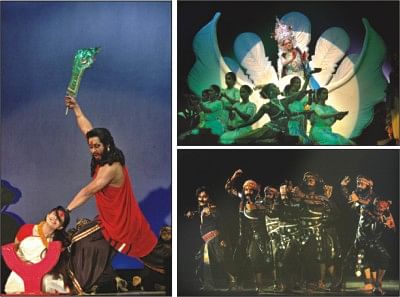Never too late to change

Shibli Muhammad (right) as Ratnakar/Valmiki (left); Shamim Ara Nipa as the Goddess Saraswati (top right); Sukalyan Bhattacharya (left) as Ratnakar’s deputy. Photo: Mumit M.
Rabindranath Tagore wrote “Valmiki Pratibha” when he was twenty. Though it's often labelled as an opera, the play is more of a musical (combining music and dance). It was first staged in 1881 and Tagore played the protagonist. The play narrates the metamorphosis of Ratnakar, a formidable bandit king to Valmiki, legendary poet-sage who wrote the Indian epic "Ramayan".
Cultural organisations Shurolok and Nrityanchal staged the play on March 12 at National Theatre Hall, Bangladesh Shilpakala Academy. City Bank and American Express presented the production. Minister for Foreign Affairs, Dr. Dipu Moni, was the chief guest at the programme.
Chanchal Khan, who conceptualised the production, said, "It is not what Europeans would call an opera, but a play set to music. Very few of the songs [from the play] attained popularity; they all serve as musical text. It took us seven months, immense patience and test of skills to bring this production to the stage." Khan is the music director of the play and lent his voice to Valmiki.
The story begins with Ratnakar and his gang unleashing a reign of terror. Ratnakar is a worshipper of Kali (the Goddess of destruction). His deputy and lackeys abduct a young orphan and bring her to the den. They intend to sacrifice her at the alter of Kali. The girl pleads, begs for mercy; forest nymphs join in the wailing. The bandit king has a change of heart. He releases the captive and earns the scorn of his mates.
The transformation begins. Ratnakar has visions: Lakshmi (Goddess of wealth) offers him endless riches. The former outlaw, however, chooses Saraswati (Goddess of wisdom) as his muse. With her blessing, Ratnakar, now christened "Valmiki", would become the Adi Kavi (the first poet) for he discovered the first œloka or verse that set the base and defined the form of Sanskrit poetry.
Several songs in the play are set to English, Scottish and Irish melodies. Contrasting that western influence, most of the solos are tappa and kheyal-based melodies.
One complaint from the audience was that the texts of the songs (a major aspect of a musical) were not comprehensible. Perhaps the set-up of the sound system was to blame.
Shibli Muhammad as Valmiki delivered a performance that cannot be flawed. Shamim Ara Nipa's role (Saraswati) was too brief for the danseuse to adequately demonstrate her craft. Two other dancers deserve mention.
Sukalyan Bhattacharya as Ratnakar's deputy made the audience laugh and gaze in amazement through his display of remarkable energy and expertise. At times the vertically challenged artiste danced like he was eight feet tall. Bhattacharya is the choreographer of the play as well.
Saheli Mahapatra was, for lack of better words, lightning on stage. In a pool of forest nymphs, she stood out, unintentionally outshining others.
On the whole, it was a mammoth production. However, razzle-dazzle seemed to weigh down the ethos at times.
Relevance of “Valmiki Pratibha”: The protagonist epitomises the universal search for identity, questioning the direction he is headed. The play refers to corruption and violence of our times. Pleading of the forest nymphs could symbolise the merciless plunder of our environment. But it's never too late to change, and change is of the essence.

 For all latest news, follow The Daily Star's Google News channel.
For all latest news, follow The Daily Star's Google News channel. 




Comments